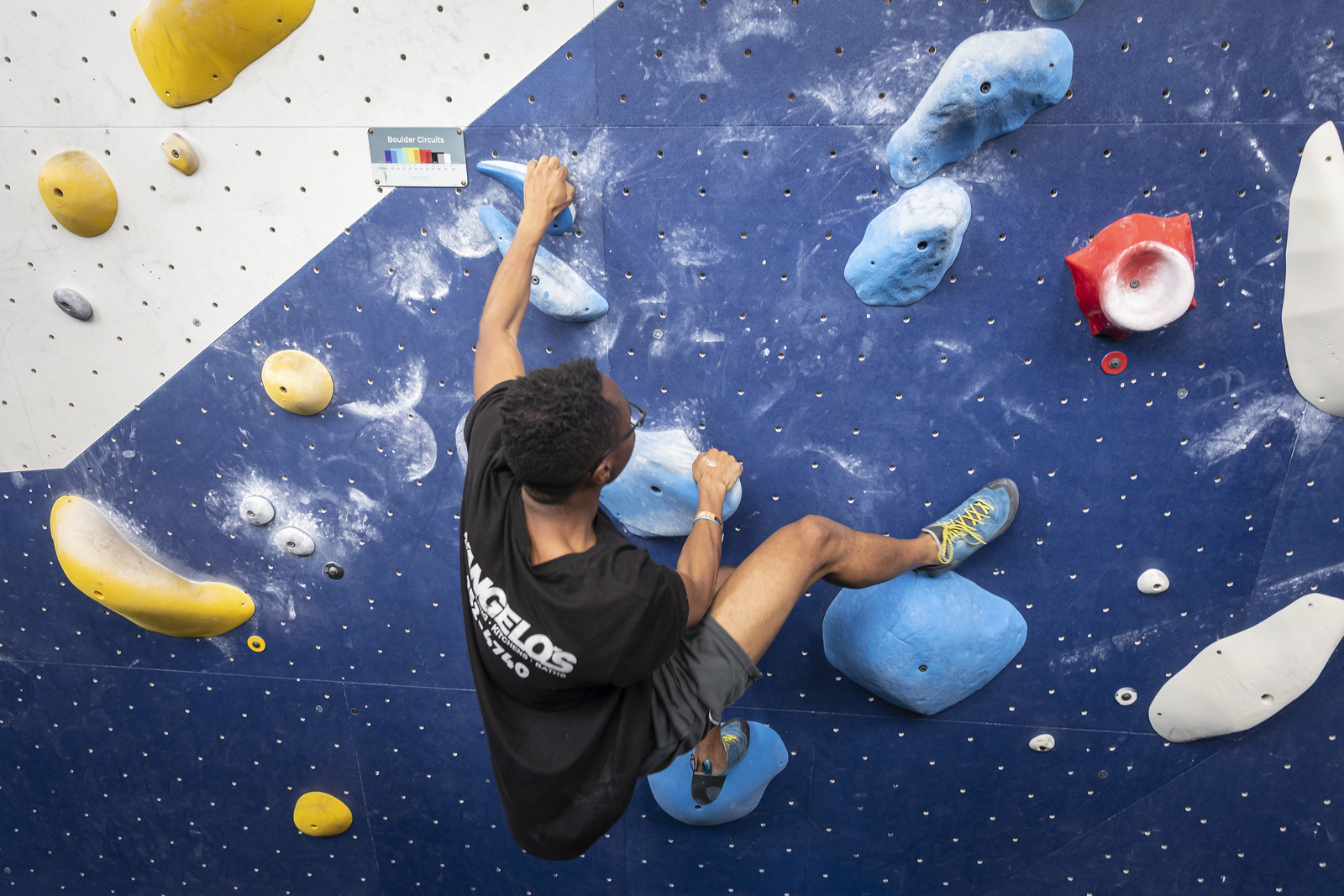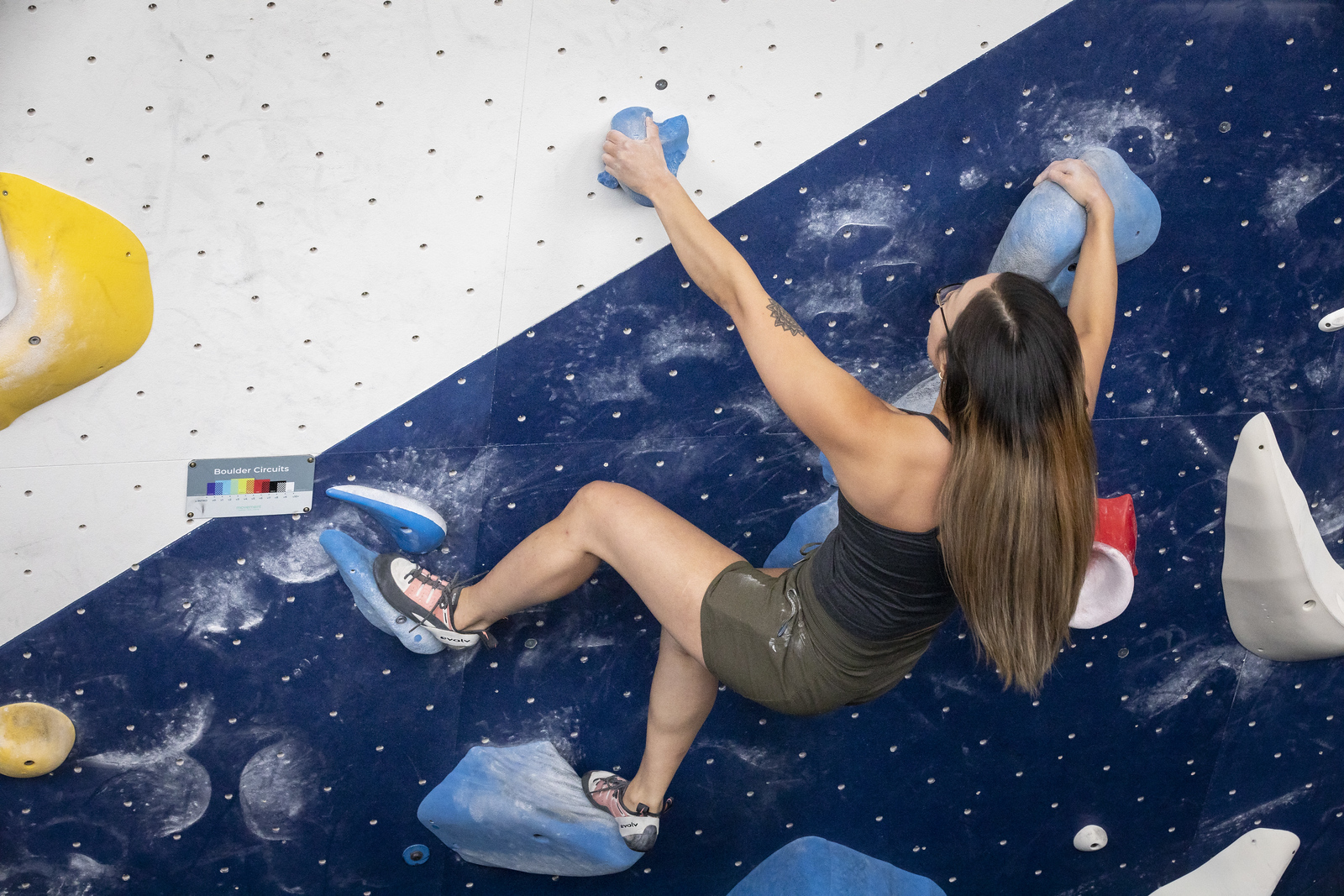On a recent warm afternoon, a restless queue 500 people deep snaked its way across the first floor of a cavernous climbing gym in Lincoln Park. They were waiting to meet Alex Honnold, a professional climber who rose to mainstream fame after scaling Yosemite’s El Capitan 3,200-feet vertical face without a rope – a feat that was captured in the award-winning documentary Free Solo.
One of the people lined up inside Movement Lincoln Park hoping to get a glance at Honnold was Tanya Chen, a 30-year-old West Loop resident, and she was hardly surprised at the turnout. “Climbers are really intense,” she said. “It kind of leans into cultishness.”
Even though Chen sees herself on the fringes of that kind of climbing culture, she is one of a growing number of Chicago millennials who find themselves packing a bag for the climbing gym a couple of nights a week instead of heading to a bar – drawn by the camaraderie, subtle competitiveness and a sense that it’s good for their mental health.
Emerging research, it turns out, might back that up.
Building a community for everybody
Community is what draws many new climbers in and keeps them coming back. Walk into a gym and you’ll likely hear the shout of affirmations – “So strong!” “You’ve got it!” “Come on!” – bouncing off the walls.
Levi Yutuc, a queer climber of color and 31-year-old Portage Park resident, used to feel intimidated by gyms and weight rooms; that changed when he began bouldering regularly in Uptown. “I would hear people just cheer each other on,” Yutuc said. “I think that’s when I started to fall in love with the sport.”
Yutuc’s introduction to climbing in Chicago came by way of a dating app. In 2018, he matched with someone who listed it as one of his hobbies. They climbed together for their first date and a couple of times after that, then never saw each other again. Yutuc continued climbing anyway. “I don’t think I could have kept going,” he said, “if not for the friends and hundreds of strangers you meet along the way, working on the same tough problem.”
“We’re all just fighting gravity.”
For many climbers, the gym is a deeply collaborative space. The routes on the walls are puzzles, and climbers work together to solve them. It is not uncommon to see a professional climber like Honnold attempting the same problem as a 11-year old competitive youth climber and a 52-year old man.
“Everybody is struggling on the same thing, together,” Honnold said. Beginners, he explained, climb in the same space as people who have climbed for decades. “We’re all just fighting gravity.”
But fighting gravity looks different for different people. For Yutuc, who has mitral valve prolapse with severe regurgitation (“in layman’s terms, a leaky heart,” he explained), that means his gym sessions run anywhere between four to six hours so that he can give himself a 10- to 15-minute break between climbs and prevent heart failure. If someone is taller or has a longer wingspan, they might have access to holds that you don’t – but that doesn’t mean you can’t still get to the top, in your own way.
Specialty climbing equipment and affinity groups help make the sport more accessible for people with disabilities. Molly Ferris, a 30-year-old living between Wicker Park and Humboldt Park, was born without a right hand but had never actively identified as part of the disabled community until she joined a local adaptive climbing group. She, like Yutuc, found her way to the gym several years ago through a date and fell in love with the physical and social high of the sport.
“The beauty of climbing is that it’s literally for every body,” Ferris said. “If you’re able to find your niche, it’s life-changing.”
Mental and physical benefits
Climbing offers more than just a supportive community and a challenging workout. It gives climbers the opportunity to work through fears and, for a few precious hours, find calm in a world that constantly feels on fire.
Even though Ferris has competed in international adaptive climbing competitions, she still remembers the terror of finishing her first ascent on an auto-belay, a rope setup that allows climbers to scale a wall without a partner. At the top, she was afraid to let go. “I was like, ‘Oh my God, what do I do?’” A stranger yelled at her to jump, and she had to trust that she would be just fine.
Ferris also appreciates how climbing slows her down. “You get to disengage from technology,” she said. “You get to look up instead of down at your phone.”
Teaierra Curry, a 27-year-old Lincoln Park resident, said that when she first started climbing in college, it felt like a moving meditation on being present and in your body. “You’re on the wall, and there’s nothing else that you have to focus on except for being on the wall,” Curry said.
In fact, climbing’s effectiveness as therapeutic treatment is an active area of clinical psychology and counseling research. Studies on bouldering psychotherapy have shown promising results in helping participants manage depression and improve their mental health. One randomized control trial concluded that group bouldering therapy was just as effective as group cognitive behavioral therapy and that its positive effects lasted at least a year.
Where can I climb?
There are eight indoor gyms in Chicago:
Brooklyn Boulders
Lincoln Park (2121 N. Clybourn Ave.)
West Loop (100 S. Morgan St.)
First Ascent
Avondale (3516 N. Spaulding Ave.)
Block 37 (108 N. State St, 4th floor)
Humboldt Park (2950 W. Grand Ave.)
Uptown (4718 N. Broadway)
Movement Climbing, Yoga, and Fitness
Lincoln Park (1460 N. Dayton St.)
Wrigleyville (1115 W. Addison St.)
If you want to be outside, you can climb in Steelworkers Park (E. 87th St. at South Lake Shore Drive) and in Maggie Daley Park (337 E. Randolph St.).
There are also gyms in several suburbs:
North
First Ascent (3400 W. Stonegate Blvd., Arlington Heights)
North Wall Climbing Gym (824 S. Main St #106, Crystal Lake)
South
Climb On Rock Gym (18120 Harwood Ave., Homewood)
West
- Vertical Endeavors (246 Windy Point Dr., Glendale Heights)
Some barriers remain
Even in a sport whose culture is often characterized as welcoming and supportive, the cost and the location of many climbing gyms in white, wealthy neighborhoods can be prohibitive. Some climbers take issue with that.
When Joel Zavala, a 34 year-old who grew up in Little Village, first visited a climbing gym, he wondered whether he was observing community or cliques. “In my personal experience, there wasn’t ever an olive branch extended – someone [saying], ‘Oh, you should try this or that’. There was a certain feeling of, ‘OK, I’m in someone else’s space’,’' Zavala said. “Even though that’s not true, you can’t help but feel that way.”
Growing up in a predominately Mexican neighborhood, Zavala internalized that climbing wasn’t for someone like him and that it was, he explained, “for lack of a better phrase – a white activity.” That changed when, at age 14, he saw someone in a Mexican soccer jersey climbing a wall in a Dick’s Sporting Goods store.
That climber took Zavala under his wing. He learned the basics of how to climb but had to stop after about a month because he couldn’t afford it.
“The interest stayed,” Zavala said. “I just didn’t have the resources.”
Chen thinks the high cost of climbing equipment contributes to the insular nature and lack of diversity in the sport. Buying a day pass in one of Chicago’s eight climbing facilities can run anywhere from $19 to $25; rental equipment adds another $6 to $11. Getting outfitted with your own gear usually starts at around $100 for new shoes, and more if you want to buy a harness, belay device or rope.
“You have to be around people of a certain socioeconomic status to even know climbing is a thing,” Chen said. “That’s why it’s mostly dominated by white people.”
Curry tries not to think too much about how she is often the only Black person she sees at her gym. When the gym asked for her permission to use a photo of her climbing to promote a local indoor bouldering competition, she agreed, but the more she saw it, the more conflicted she felt. “I’m glad that [the gym was] showing people of color doing things that we don’t necessarily get representation for,” Curry said. “But I also felt like I was being tokenized.”
“Who I am as a person, as a Black woman, greatly affects every single thing that I do,” she continued. “I feel like the biggest grievance I have with climbing is that climbers who are, like, white and wealthy, do not understand that.”
Some climbers acknowledge that gyms are trying to make their facilities more accessible and welcoming by implementing sliding scale memberships and hosting groups like the Adaptive Climbing Group, Queers on the Rocks and Sending In Color. Still, some climbers argue, gyms can and should do more to show their support.
“There’s a lot of top-down things that can be done,” Chen said.
Still, Curry feels grateful for how her experiences climbing – both the good and the bad – have helped her grow and understand herself better.
“The things I do on a wall to problem solve, to make sure I keep moving forward, to rest when I feel like I need it – those have all been things that I’ve applied to my real life,” she said.
And, she added, in a world where millennials feel pressured to squeeze an increasing number of activities into a fixed amount of time, the climbing gym is one of very few places where she can spend time with friends, meet new people, get a workout in and relax – checking a lot of boxes for an exhausted and anxious generation.
“You’re on the wall, and there’s nothing else that you have to focus on except for being on the wall”
“It’s the perfect balance of being productive, which I think our generation specifically has an obsession with, but also being able to have fun and be around people with good energy,” she said.
When Curry left college and moved to Chicago, she thought it unlikely she’d find again the welcoming, adventurous climbing community that had embraced her on campus. That experience, she thought, was limited to a specific season of life. So when she discovered that same warmth and care at a gym in Avondale, she felt at home.
That’s what climbing really is, she learned. It’s a community.
Charmaine Runes is WBEZ’s data/visuals reporter. Follow her @maerunes.












